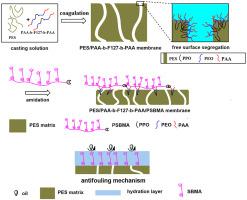Polymer ( IF 4.1 ) Pub Date : 2021-09-13 , DOI: 10.1016/j.polymer.2021.124177 Jun Yin 1 , Hui-fang Zhang 1

|
The block copolymer, Pluronic F127-block-poly(acrylic acid) (PAA-b-F127-b-PAA) was firstly synthesized via RAFT polymerization. Then, the copolymer was utilized as the blending modifier for fabricate polyethersulfone (PES)/PAA-b-F127-b-PAA composite membrane by nonsolvent induced phase separation technique. The hydrophilic PAA segments were concentrated onto the membrane surface due to the surface segregation phenomenon in the membrane formation process, which improved the hydrophilicity of the membrane surface and provided active sites for further surface grafting modification. Subsequently, the amine-terminated poly(sulfobetaine methacrylate) (NH2-PSBMA) was prepared through ARGET ATRP and used as surface modifier to fabricate PES/PAA-b-F127-b-PAA/PSBMA composite membrane by amination reaction. The composite membrane exhibited the highest pure water flux and oil flux around 358.25 and 217.53 L m−2 h−1, which equal to 5.6 times and 19.6 times of unmodified PES membrane respectively. The flux recovery rate increased from 45.74% to 94.64%, suggesting the fouling-resistance of the composite membranes was greatly improved. The hydrophobic PPO segments of PAA-b-F127-b-PAA used as anchor segments and amalgamated with PES molecular by hydrophobic interaction and physical intertwisting, resulting in the PAA-b-F127-b-PAA was firmly embedded in the membrane. Moreover, the PSBMA segments were grafted onto the membrane surface by forming strong chemical bonds, exhibiting excellent stability. It shows that this membrane material prepared by physical blending and surface grafting has a good application prospect in oil/water separation.
中文翻译:

物理共混和表面接枝相结合的聚醚砜膜亲水改性以实现油水分离
嵌段共聚物 Pluronic F127-嵌段-聚(丙烯酸)(PAA-b-F127-b-PAA)首先通过 RAFT 聚合合成。然后,将该共聚物用作共混改性剂,通过非溶剂诱导相分离技术制备聚醚砜(PES)/PAA-b-F127-b-PAA复合膜。由于膜形成过程中的表面偏析现象,亲水性PAA链段集中在膜表面,提高了膜表面的亲水性,为进一步的表面接枝改性提供了活性位点。随后,胺封端的聚(磺基甜菜碱甲基丙烯酸酯)(NH 2-PSBMA) 通过 ARGET ATRP 制备,并用作表面改性剂,通过胺化反应制备 PES/PAA-b-F127-b-PAA/PSBMA 复合膜。复合膜在 358.25 和 217.53 L m -2 h -1附近表现出最高的纯水通量和油通量,分别相当于未改性PES膜的5.6倍和19.6倍。通量回收率从45.74%提高到94.64%,表明复合膜的抗污染性有了很大的提高。PAA-b-F127-b-PAA的疏水PPO链段作为锚链段,通过疏水相互作用和物理缠绕与PES分子融合,使PAA-b-F127-b-PAA牢固地嵌入膜中。此外,PSBMA 链段通过形成强化学键接枝到膜表面,表现出优异的稳定性。表明这种物理共混和表面接枝制备的膜材料在油水分离方面具有良好的应用前景。











































 京公网安备 11010802027423号
京公网安备 11010802027423号